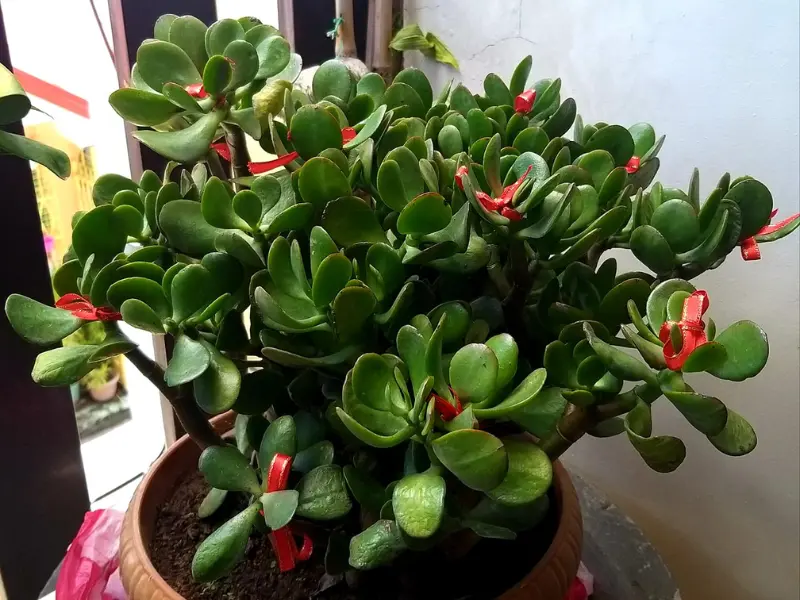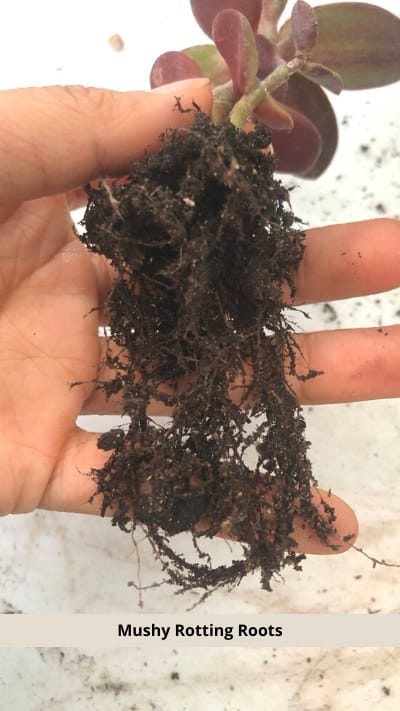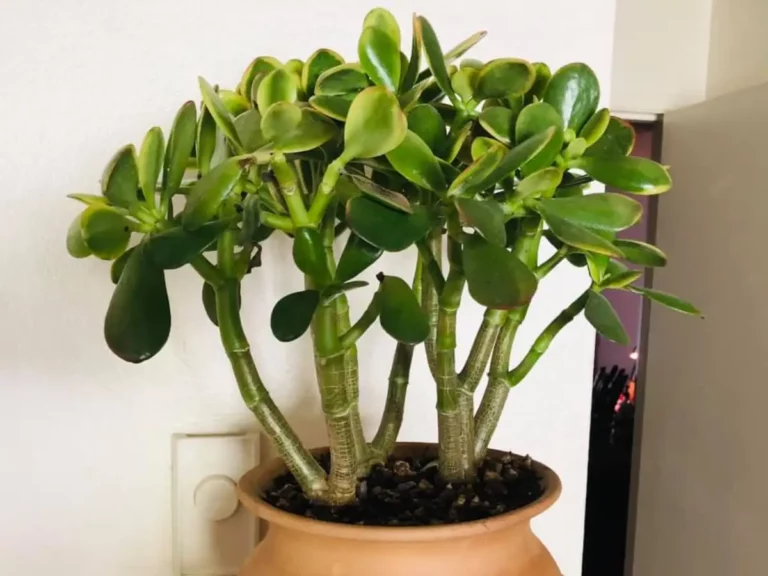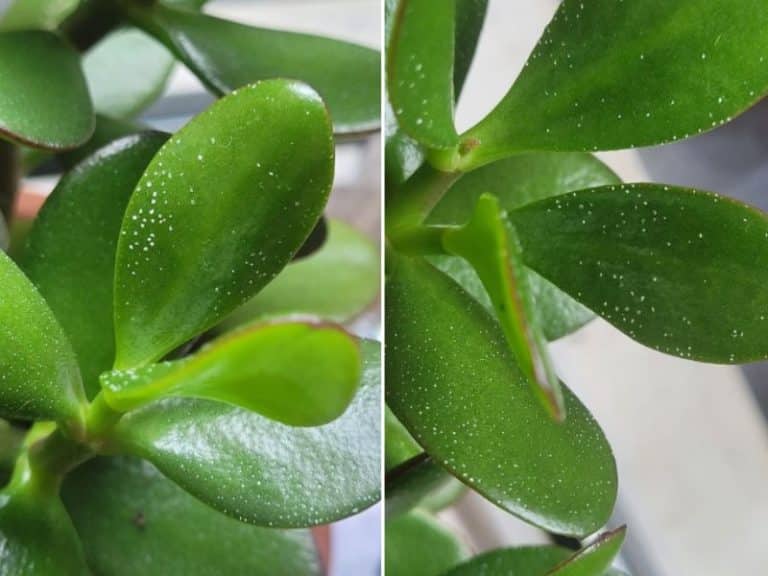How to Save a Jade Plant from Root Rot
Root rot is one of the leading causes of death in jade plants. If you can identify and treat the plant in good time, it can be saved and will continue to grow and thrive. Root rot disease progresses gradually, meaning you can save your plant if you notice the signs early.
To save your plant from root rot, remove it from the container and examine the extent of the damage. If the plant’s roots are rotten, prune them, treat the remaining ones with a fungicide and replant the remaining plant afresh in a new potting mix. Adjust your watering schedule to prevent further root rot incidents.

What should healthy jade plant roots look like?
The roots of a healthy jade plant should be white and fleshy with spongy tissue but hollow on the inside. They do not grow extensively and may be considered shallow, but they are firm in the soil.
The root’s appearance is usually affected by overwatering, underwatering, bacterial soft rot, or fungal diseases.
Rotten jade plant roots cannot absorb water. They become slimy and brittle. They also change color from white to brown or black.
JADE PLANT: BEST TIPS + TRICKS

I’ve put together tips and tricks for healthier, happier jade plants that I’ve learned over the years in a single guide for you.
Signs of root rot in jade plants
As a low-maintenance plant, it is easy to ignore close monitoring of your jade plant. However, occasional checkups can help you identify early signs of root rot. The following signs are the most common in root rot-affected jade plants.
Brown roots
Brown roots with soft tips are a glaring indicator of root rot in jade plants. The decaying roots also have an unpleasant odor.
The extent of the damage to the roots will only be visible if you remove the plant from the pot.
Limp and shriveled jade plant
Wilting, sparse foliage, and branch dieback are also common signs of root rot. The jade plant leaves will also be soft and squishy because their cells cannot hold the water.
The stems cannot support the plant because they are weak. The plant can even begin caving and eventually collapse.
Yellow leaves and pale stems
Jade plant leaves and stems exhibit signs in the advanced stages of root rot. The rotten roots introduce a chain of reactions that affect the whole plant. The lower leaves and stems become pale and yellow.
Once the signs affect the leaves and stem, it may be difficult to reverse the root rot.
Causes of root rot in jade plant
For a plant native to dry areas in Africa, root rot in jade plants is mainly a water problem. Any secondary causes might be from negligence, especially if the plant is indoors.
Overwatering and drainage issues
Jade plants thrive with minimal water. Therefore, the plant is more at risk of overwatering than underwatering.
Poor drainage and heavy soils compound the waterlogging problem. Potted jade plants are more susceptible to overwatering and poor drainage. Potting problems mainly stem from improper drainage outlets.
Pathogens
Pathogens can cause root rot in jade plants.
These pathogens could be dormant in the soil or growing media for a while. Nematodes and other microorganisms cause root rot when they feed on the roots’ wounding.
Bacterial soft rot
The jade plant gets infected with a soft rot bacteria that causes the structure of the plant’s parts to fall apart. Bacterial soft rot causes the plant to rot from the inside out, making it slimy and smelly. The branches and leaves will wilt and eventually collapse.
Root rot caused by bacteria or fungi may exhibit the same signs as overwatered ones but will require different treatment.
Can a jade plant recover from root rot?
Your jade plant can recover from root rot depending on the extent of the damage. The best solution to adverse root rot is to cut the affected part. You can save the roots if there is still some white part remaining. However, it would be difficult to salvage the plant if the entire root is severely damaged.
Since it is impossible to reverse advanced damage or heal the plant using chemical products, cutting out the affected roots, stems, and leaves is the most viable solution.
You can propagate a jade plant from the remaining stem and leaf cutting. Within a short time, the plant will sprout and grow afresh.
How to save a jade plant from root rot
Leaving the plant to heal by itself rarely works on the jade plant. Root rot spreads rapidly. Therefore, it is crucial to act immediately after you notice the signs. Follow these steps to save your jade plant from root rot.
1. Unpot the plant

You cannot see root rot when it’s still in the early stages affecting only the roots. Remove the plant from the pot to inspect the plant.
Keep the rootball intact when you remove the plant. The best approach is laying the pot on the side and sliding a flat item along the pot’s inner walls.
It might suffer mild shock, but the jade plant will tolerate being removed and returned to the pot.
2. Examine the roots for signs of root rot
- Shake off the soil around the rootball to expose the roots.
- Rinse out the roots under running water.
- Inspect the damage on the roots.
If the roots have turned brown, you will notice the discoloration. Healthy roots are white or brown. Rotten jade plant roots are black and slimy.
There will also be an unpleasant odor of rotten vegetation. Rotten roots also break easily, while healthy roots are firm.
3. Prune the rotting roots
The only viable solution to rotten roots is cutting them.
- First, disinfect the pruning shears or scissors using alcohol.
- Snip off the damaged roots that are black, smelly, and brittle. Cut about 2 inches above the rotten area.
- Cut the infected piece and dry out the rest to salvage the remaining part of the plant. Also, remove any limp, squishy, or discolored leaves.
- Sterilize the shears or scissors to prevent the spreading of infections after pruning.
In extreme cases, you should behead the jade plant. Beheading requires you to cut small cuttings so that you can propagate again. Dry the cuttings for a few days in the sun to prevent rotting.
4. Repot the plant in a new potting mix
Propagate the healthy cutting in a new pot even if the roots did not survive.
- Fill the pot halfway with well-drained succulent soil. You can use vermiculite or perlite to improve soil drainage.
- Insert the cutting on the surface of the moistened soil.
- Pat the soil firmly around the jade plant.
- Place the plant in a dry area with enough sunlight to grow.
- Water at an interval of 7-14 days and avoid fertilizing for one month to give the plant time to adjust.
If all the roots were cut, wait for the remaining stem to form a callus and propagate it. You can speed up propagation by placing the cuttings in root growth hormone. Make sure you use a pot with proper drainage.
Correct the overwatering problems by reducing the frequency of watering. Apply the appropriate fungicides to prevent further and future bacterial or fungal attacks.
Be patient. The jade plant takes time to develop new roots.
Caution: Wear protective clothing and gloves because jade plants can be toxic. Also, keep the pets and children away from the cuttings.






